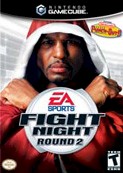Review: Fight Night Round 2
Posted 30 Apr 2005 at 07:16 by Wouter
GC Review
Boxing games never really changed that much since Punch-Out on the NES. Okay, that's not completely fair, graphics improved and more buttons are used to control your fighter, but the basics are the same. You move your boxer around, dodge or block your opponent's punches and use the controller's buttons to dish out damage of your own. While this works pretty well and is fun to play, it's not really a good simulation of a real boxing match. Pressing buttons may be a simple way to make a boxer punch, but it's far from the timing, balance and aim involved in throwing a real punch. EA thought so too, so they decided to overhaul the control interface of boxing games. Like in Tiger Woods you primarily use the analog sticks to control your athlete, in Fight Night 2004 the left one is used to move your boxer around, the right one is used to move his arms. This setup made the first Fight Night a refreshing game to play if you had a PS2 or an X-Box, because there was no Cube version available. EA tries to right this terrible wrong by giving the Cube a version of Fight Night Round 2, the sequel to Fight Night 2004.
Punch with your thumb:
Let's get back to that control setup before we delve deeper into Fight Night Round 2. As mentioned before you primarily use the analog sticks to control your fighter. The left side of your controller is for moving the body of your boxer; moving the control stick makes him walk, moving the control stick in a direction while holding L makes him lean that way. This gives you a good way to defend yourself right from the start; lean back as your opponent throws a hook at you and his glove will hit nothing but air. The right side of your controller is dedicated to what makes boxing fun: using your fists. The idea is so simple it's almost strange nobody thought of it before. If you want to throw a right hook, you just tilt the C-stick to the right and move it counterclockwise until it's pointing up, the same motion your arm makes when it's doing a right hook. To do a right jab you just tap your C-stick to the top-right, while rotating the C-stick from down-right to upwards pulls of a right uppercut. If you hold R and move the C-stick your boxer blocks with his fists in the direction you point. It takes a little getting used to, but after a few lost matches you won't want to go back to pressing buttons, the analog sticks give you much more precision and control. A new addition to this year's Fight Night is the Haymaker punch. If you really want to do damage to the other fighter, pull back your fist a bit before throwing a hook or uppercut and you'll give him a punch to remember.
Pacing is everything:
Now you know how the game controls, but just ramming the C-stick around like crazy isn't going to get you anywhere. Like real boxers your fighter can get tired, causing him to miss punches and lose his strength. You get tired faster if you miss a lot of punches or if your punches get blocked, so a good way to avoid this is to attack only of you know your punch will land. A good way to do that is luring your opponent into punching you, dodging or blocking his punch and quickly landing a counterpunch. Landing a Haymaker punch requires more precise timing, as it's more difficult to create an opening if your opponent can see you charging a punch. The importance of timing and strategy gives the fighting a lot of diversion, you can pick fast boxers and dance around your opponent while teasing him with lots of quick jabs or you can go for the slower stronger types and pummel your opponent's face with counterpunches and Haymakers. Especially when playing against the computer you'll need to observe your enemies' tactics and respond to them accordingly, because the computer will do exactly the same to you.
More than just a pretty face:
Like a lot of EA's sports titles, the game is filled with fighters that look frighteningly much like their real life counterparts. Most of today's more popular boxers are included in the line-up, and a few old legends are also present (what good is a boxing game without Muhammed Ali?). Like in just about every game nowadays you can also create your own fighter, this time with one of the most customizable systems you can imagine. You can recreate your own likeness to incredible detail, if you don't mind your ingame version being a bit more muscular than the version you'll find in the mirror. All these detailed faces can also be bashed up until they're not so recognizable anymore. All your punches leave marks, and the more punches you land in one specific area of someone's face, the bigger the mark it leaves. If a boxer's face really starts to get bad it even has influence on his performance; if his right eye is swollen shut his right punches will lose a lot of accuracy. It can even get worse; if punches start leaving cuts the referee might force the wounded boxer to retire from the match. Luckily you can reduce the damage done to your fighter's face a bit between rounds. In a small minigame you can take care of his face to reduce his bruises and stop the bleeding from his cuts. This gives you something to do while listening to advise from your coach on how to tackle the next round.
Presentation:
All this strategic violence is presented in the usual big budget EA way. The boxing animations are great, especially the knockouts look very convincing; the hilarious epileptic ragdoll stutters of Fight Night 2004 are a thing of the past. The camera makes sure you know when a punch did it's job; if you land a really painful punch the view goes a bit crooked, as if you just landed a hook on the cameraman as well. The game's soundtrack is a bit limited, there are a lot of songs but they're all the same type of rap music, which is okay if you like that but can get boring quickly if you don't. The game also has enough game modes to keep you interested for a while. There are two types of career modes, one where you create your own fighter and take him to the top, and one where you pick an existing boxer and replay his success story. Between the matches you can choose to train specific attributes of your fighter through a couple short minigames and buy outfits or signature punches wit the cash you've earned in your fights. The outfits are more than just new looks, they also influence your boxer's stats, making customizing your wardrobe feel like more than playing with Barbies.
Final Say:
The GameCube can use every fighting game it can get right now, and with Fight Night Round 2 it got a really solid one. The strategic long fights are a welcome relieve from the button mashing found in most other boxing games, you really have to observe and react to win matches. The Cube version of Fight Night Round 2 misses out on the online matches the X-Box and PS2 versions have, but it throws in Super Punch-Out!! as a free bonus. Super Punch-Out!! is emulated perfectly and is still a lot of fun to play, and if you finish it completely you can even use Little Mac as a fighter in Fight Night. If you're into deep and involving fighting games you can't go wrong with Fight Night Round 2, and the unique control system also makes it a great multiplayer title. Playing with friends is even more fun after you've created boxers in their likeness so you're beating up a familiar face. You might argue that we should've been able to play Fight Night 2004 on the Cube as well, but this game improves on 2004 in so many ways it's hard to complain.
N-Europe Final Verdict
A deep but also fun fighting game
- Gameplay4
- Playability4
- Visuals4
- Audio4
- Lifespan4
Final Score
8
Pros
Excellent controls
Lots of strategy
Great visuals
Super PunchOut!!
Cons
Limited soundtrack























